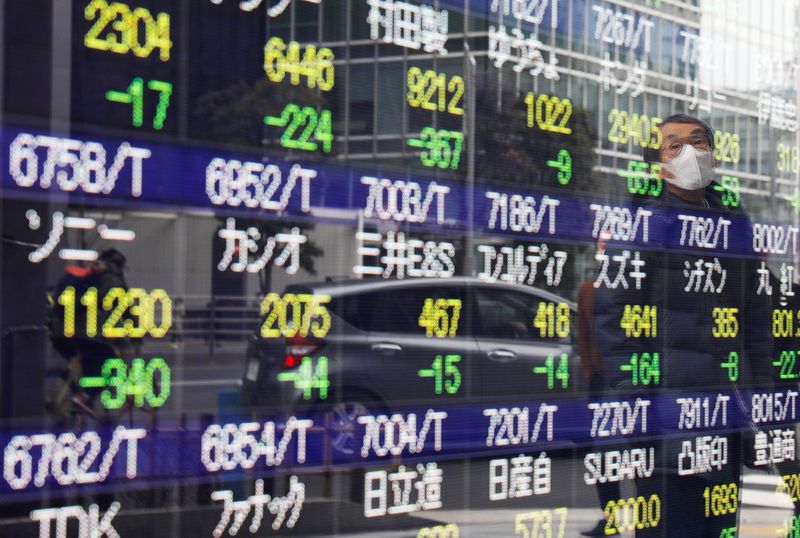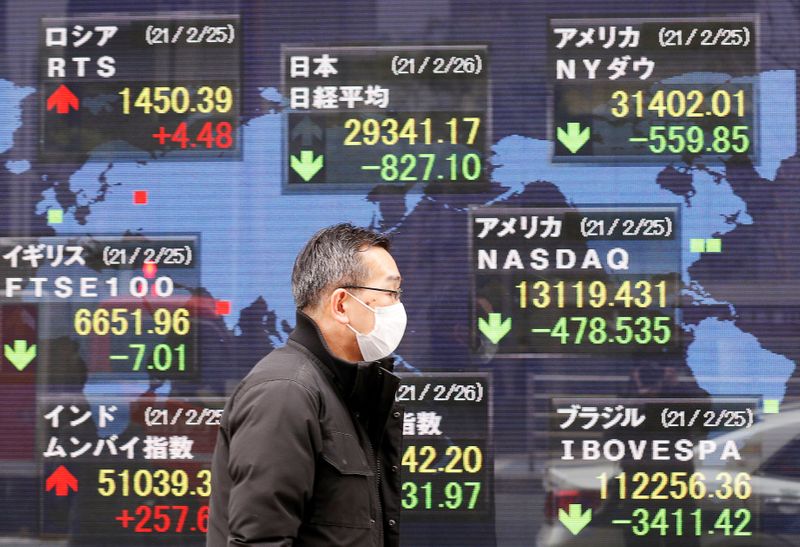
Eden
Oct 25, 2021 14:07
By Stanley White and Elizabeth Dilts Marshall
TOKYO/NEW YORK (Reuters) - Asian shares and U.S. stock futures rose on Thursday after the Federal Reserve committed to maintaining accommodative monetary policy and projected a rapid jump in U.S. economic growth this year as the COVID-19 crisis eases.
MSCI's broadest index of Asia-Pacific shares outside Japan rose 0.87%, while stocks in China rose 0.74%. Australia's market bucked the trend and fell 0.73%.
E-mini futures for the S&P 500 edged up by 0.7%.
Euro Stoxx 50 futures were up 0.52%, German DAX futures rose 0.75%, and FTSE futures were up 0.4%, pointing to a bright start to European trading.
While inflation is expected to reach 2.4% this year, above the central bank's 2% target, Fed Chair Jerome Powell called it a temporary surge that will not change the Fed's pledge to keep its benchmark overnight interest rate near zero.
Long-term Treasury yields remained elevated and the yield curve steepened as bond investors chose to focus more on rising inflation expectations.
The yen erased losses and government bond yields briefly rose after a media report that the Bank of Japan will agree to allow yields to trade in a wider band when it ends a two-day policy meeting on Friday.
"If the Fed isn't going to induce tightening, it's very bullish for risky assets," said Teresa Kong, head of fixed income and portfolio manager at Matthews Asia. "We should be seeing a mild rally in Asian assets and currencies."
Shares in South Korea and Singapore also jumped more than 1%, taking their lead from a strong session on Wall Street.
The S&P 500 closed at a record high on Wednesday and the Dow Jones Industrial Average closed above 33,000 points for the first time, bolstered by the Fed's strong economic forecast and Powell's comments that it is too early to discuss tapering-off measures.
MSCI's gauge of stocks across the globe gained 0.35% to approach an all-time high.
The Fed projected the U.S. economy would grow by 6.5% this year - the largest annual output growth since 1984 - thanks in part to massive federal fiscal stimulus and optimism around the success of coronavirus vaccines.
"It's sort of shocking ... that officially the United States government believes it will grow faster than the Chinese government believes it will grow this year," said Christopher Smart, chief global strategist at Barings Investment Institute in Boston, calling it a "head-turning moment for investors." The yen erased losses and steadied at 108.94 per dollar after the Nikkei newspaper said the BOJ will allow 10-year bonds to move up to 0.25% above or below zero, which is slightly wider than the current band of 0.2%.
Japan's benchmark 10-year government bond yield briefly rose and futures fell, but the focus shifts to the outcome of the BOJ's meeting on Friday.
The Australian dollar jumped to a two-week high of $0.7835 after data showed the nation's economy created more than twice as many jobs as expected in February.
Benchmark 10-year U.S. Treasury yields edged up to 1.6639%, not far from the highest since January last year.
The spread between two-year and 10-year U.S. yields, the most-keenly monitored part of the yield curve, rose to 155 basis points, which is the steepest since September 2015.
The 10-year inflation breakeven rate hit 2.309%, which shows that inflation expectations are at the highest since January 2014.
Oil futures extended declines, weighed down by rising U.S. crude inventories and by expectations of weaker demand in Europe, where the coronavirus vaccine roll out is faltering.
Brent crude fell 0.63% to $67.57 a barrel, and U.S. crude declined by 0.57% to $64.23.
Spot gold rose 0.35% to $1,750.83 per ounce by 0119 GMT, while U.S. gold futures climbed 1.1% to $1,745.80 per ounce as the Fed's pledge to keep rates low and worries about inflation pushed up the precious metal.

Oct 25, 2021 14:07

Oct 25, 2021 14:07